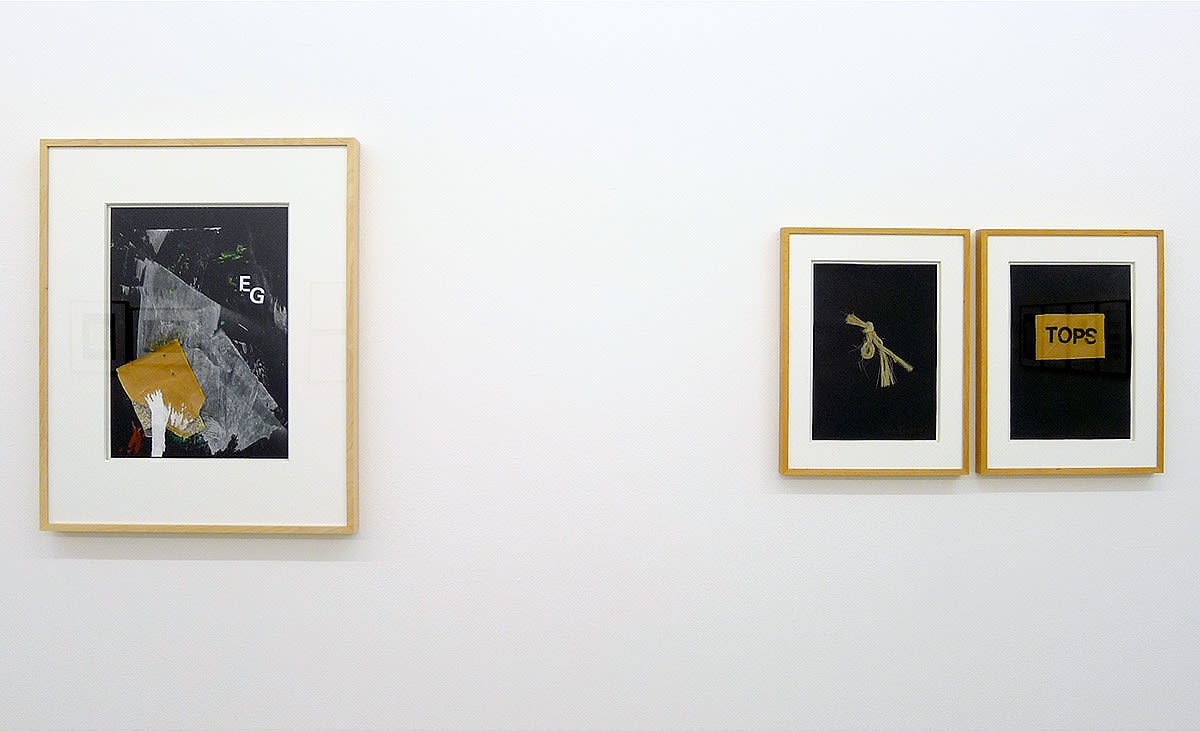The Sonosopher Goes Visual: Sten Hanson
Swedish composer and sound poet Sten Hanson, who this year celebrates his 50 year anniversary as a professional artist, shows for the first time his collages, drawings, writings and notes, These highly personal works from one of the pioneering figures in experimental music, performance and poetry represent the foundation or equation for thousands of Hanson performances in radio, television and concerts.
This exhibition at Niklas Belenius Gallery is the celebration of the release of a new complete book of Hanson’s visual works , “Poetic Works and music without tears”, published by Gallery Niklas Belenius, Tragus Forlag and Firework bookform. Hanson’s drawing have not just stayed in a desk drawer. They have been printed and reprinted in magazines and anthologies, mostly with very limited circulation, and/or been shown in exhibitions and galleries.
Sten Hanson points out, “Because I have made relatively few works on paper over long intervals of time, it has never seemed necessary to publish books. But now towards theend of my life, I feel that the time for this book of visual works has come.” Many of the pieces exist not only on paper but also as sound and/or video compositions. Since every medium has its own features and treats the same material from differentangles, it is interesting to compare the differences between them in current works and those works made in the early sixties
Sten Hanson is one of the forerunners in the field of multi-media art. From early on, he was aware of the importance of tape-recording techniques in the renewal and development of poetic resources. Text-sound-visual image, often combined with intensely personal ‘live” performances, are vital ingredients in Sten Hanson’s artistic workmanship.
Sten Hanson, was leader of the Fylkingen language group from 1968 and in charge of the Text-Sound Festivals which span many years. He is self-taught as a composer. In Sweden, he was Director (1968-1977) and then Chairman (1980-1984) of the concert organization Fylkingen, chairman of the ISCM (1975-1981), member of the Royal Academy of Music of Sweden and President of the Swedish Composers’ Union (1985-1994), member of the Executive Committee of International Confederation of Electroacoustic Music (ICEM) (1981-1982) and Chairman of this organization from 1997 to 2002. He has been member of College compositeur de GMEB from 1982, member of the Executive Committee of the International Society for Contemporary Music (ISCM)from 1982, member of the Executive Committee of the Electronic Music Studio, and Chairman of the Society of Swedish Composers (1984-1994).
Sten Hanson has been working with experimental music, literature and art since the beginning of the 1960’s, cultivating instrumental, vocal and electro-acoustic music for performance on radio and television, on outdoor occasions and from the concert platform. From an early stage he was aware of the importance of tape-recording techniques in the renewal and development of poetry’s resources. Text-sound-visual image, often combined with intensely personal ‘live” performances, are vital ingredients in Sten Hanson’s artisticworkmanship and he is ore of the forerunners in the field of multi-media art.
Sten Hanson has been on numerous performing and lecturing tours all over the world. He was quick to realize the importance of the tape recorder as a factor in the renewal of poetry and the ability of text-sound compositions to break the isolation often experienced by an author in a small language area. His works include electro-acoustic pieces as well
as instrumental and vocal compositions.
From the end of the sixties up to 1979, Hanson worked essentially with electroacoustic music and created, with Lars-Gunnar Bodin, Ã…ke Hodell, Bengt Emil Johnson, the theory and the practice of a new aesthetic field: “The electronic text-sound”. Sten Hanson realized a large number of works in various styles : works for television, ballet music, performances, audiovisual performances assisted by computer, pieces for instruments and tape and/or electronics, works for orchestras and computer music. Many of his early compositions were short, hard hitting collages of text and sound with a socially and politically committed content: Che (1968), Western Europe (1969), Revolution (1970). In other works the emphasis was more on humorous burlesque: Coucher et souffler (1968),How are You (1969). Compositions like Fnarp(e) (1970) and L’Inferno de Strindberg (1971) have passed through more extensive electro-acoustic processing, as is also the case in the humorous but cautionary The Flight of the Bumblebee (1982).
The voluminous John Carter Song Book (1979-1985) is based on the early science fiction writer Edgar Rice Burroughs’ texts concerning the American Captain John Carter´s adventures among the red men of Mars. In principle this is pentatonic music, but with a lavish flora of glissandi and microtonal elements. The vocal elements have been synthesised at the computer studio of Brooklyn College, New York.
Wiener-Lieder (1985-1986) for soprano, piano and recorded tape was first performed at the 1987 Swedish Music Spring Festival. In a series entitled Play Power (e.g. No. I 1961, No. IX 1982) Sten Hanson has used the potentialities of an instrument together with a recorded track featuring the characteristics of the instrument.

